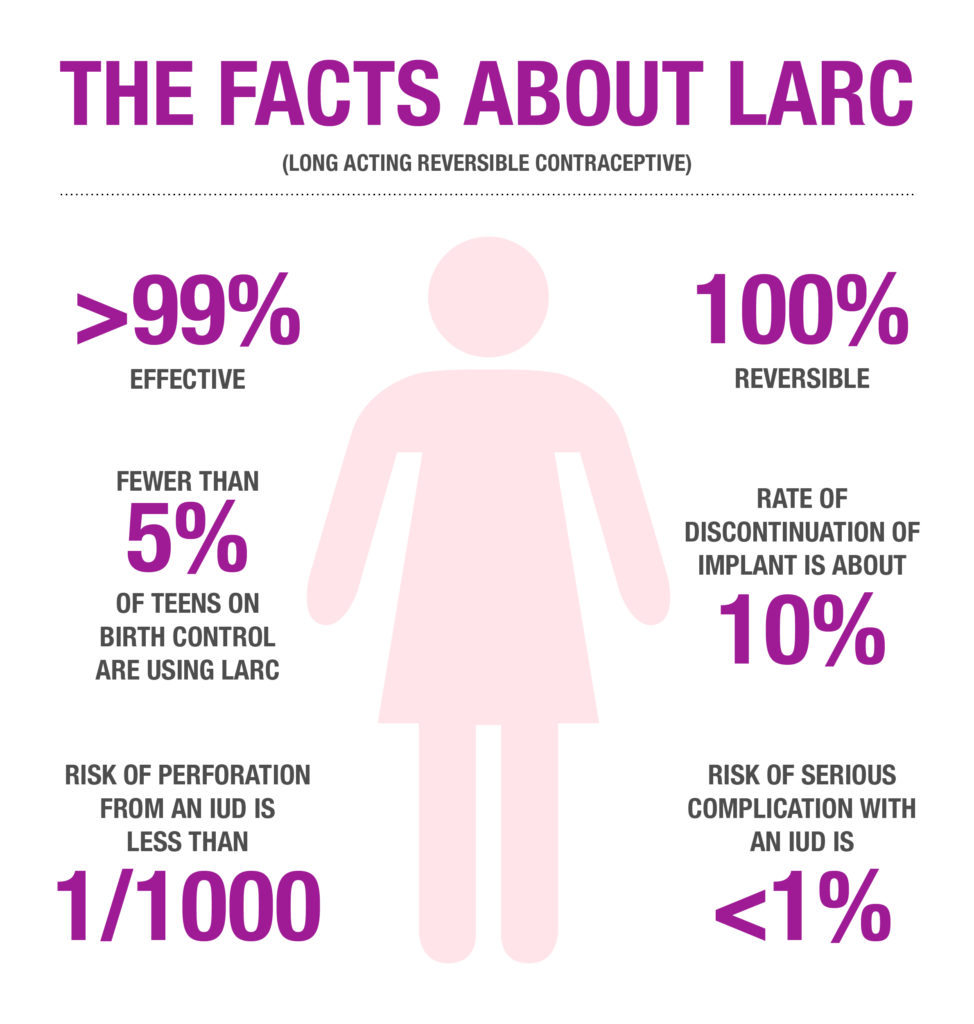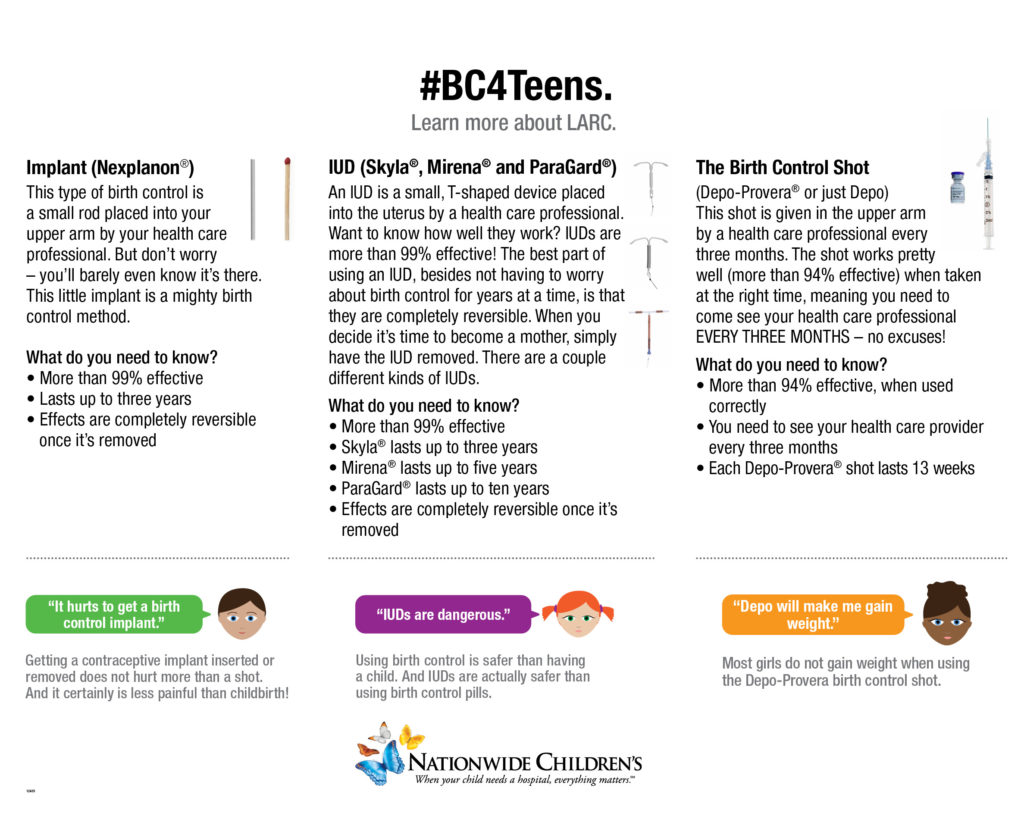Long Acting Reversible Contraceptives: A First-Line Approach to Prevent Teen Pregnancy
Long Acting Reversible Contraceptives: A First-Line Approach to Prevent Teen Pregnancy https://pediatricsnationwide.org/wp-content/themes/corpus/images/empty/thumbnail.jpg 150 150 Elise Berlan, MD, MPH Elise Berlan, MD, MPH https://pediatricsnationwide.org/wp-content/uploads/2021/03/Elise-Berlan.jpg- May 31, 2016
- Elise Berlan, MD, MPH
Unplanned teen pregnancies remain a problem in American society. In the United States, 82 percent of teen pregnancies are unplanned, and the United States has the highest teenage pregnancy rate among high income nations.
Despite being highly effective and safe, misconceptions around long acting reversible contraceptives (LARC), such as etonogestrel implants and intrauterine devices (IUDs), prevent many teens from obtaining them, leaving them at risk for an unplanned teen pregnancy.
Providing teens with access to LARC is vital to decreasing the teen pregnancy rate and the adverse outcomes associated with teen births. Many teens maintain lifestyle risk factors such as tobacco use, increased rates of sexually transmitted infections and lower likelihood of receiving early prenatal care, all of which lead to poorer outcomes at delivery. Teen mothers are also more likely to deliver pre-term infants, which is a leading cause of infant mortality.
Pediatricians are champions of health and have opportunities to decrease unintended teen pregnancy through preventative counseling and provision of LARC. Unfortunately, pediatrician attitudes and beliefs about LARC usage in adolescents can be a barrier to providing the best care for our teens.

The American Academy of Pediatrics, Centers for Disease Control and Prevention, Society for Adolescent Health and Medicine, and American Congress of Obstetricians and Gynecologists recommend LARC methods be considered first-line contraceptives for adolescents. Yet, fewer than 5 percent of adolescents using contraceptives are using a LARC method. Insufficient medical information and outdated attitudes among health care providers, especially pediatricians, contributes to the low use of IUDs among adolescents.
Intrauterine Devices
Pediatricians’ concerns around side effects and adverse events, such as pelvic inflammatory disease (PID) and infertility, limit their interest to offer and provide IUDs to adolescents. Pediatricians also have unrealistic beliefs on expulsion rates and negative assumptions about the ability of adolescents to tolerate IUD insertion. IUDs are more than 99 percent effective, safe and well tolerated. They don’t contain estrogen and can be used in patients with contraindications to estrogen.
Three types of hormonal IUDs (Mirena®, Skyla® and Liletta®) and one copper IUD (Paragard®) are available in the United States. Skyla®, Liletta® and Paragard® are all FDA approved for use in nulliparous females. Regarding IUDs, healthcare providers should know the following information:
- Contemporary IUDs are not associated with infertility.
- Teens and young women tolerate IUD insertion well.
- The risk of pelvic inflammatory disease is ONLY increased for 20 days after the insertion of an IUD.
- The risk of perforation is less than 1/1,000.
- The risk of a serious complication is <1%.
Mirena® and Liletta® are effective for 5 years, Skyla® is effective for 3 years, and Paragard® is effective for 10 years. Mirena® is also FDA-approved for the treatment of heavy menstrual bleeding. In most instances, IUDs can be placed in an outpatient visit by a trained health care provider.
Contraceptive Implant
The most effective hormonal contraceptive is Nexplanon®, also known as the arm implant. This method is 99.95 percent effective in the first year of use. Nexplanon® contains the hormone etonogestrel, which is a progestin. There is no estrogen in this method, and it is safe for use by girls and women who have contraindications to estrogen, such as migraines with aura or blood clots. Nexplanon® works by primarily by suppressing ovulation, like DepoProvera® and birth control pills. It lasts for three years. The most common side effect is unpredictable bleeding.
We conducted a study at Nationwide Children’s Hospital on adolescents’ discontinuation of Nexplanon® and found that only 10 percent of girls with Nexplanon® had the device removed within the first year. It can be placed quickly (within a minute) in an outpatient visit.
Pediatricians have unique access to the ever elusive adolescent patient. While time in office can be limited, improving pediatric health care providers knowledge about IUDs and the contraceptive implant has the great potential to improve LARC usage among adolescents and decrease unplanned teen pregnancy.

Support for Pediatricians and Patients
IUDs and implants, as well as other contraceptive methods, are available from the experts at Nationwide Children’s Hospital’s BC4Teens/Young Women’s Contraceptive Services Program. BC4Teens is a teen-friendly birth control clinic that provides a spectrum of family planning services for teens and young adult women. Support for providers is available online or via the Physician Direct Connect hotline: (614) 355-0221 or (877) 355-0221.
About the author
Dr. Berlan is a physician in the Section of Adolescent Medicine at Nationwide Childcare’s Hospital and associate professor of Pediatrics at The Ohio State University College of Medicine. She is a researcher, educator, clinician and advocate for young women’s reproductive health. As founder and director of the BC4Teens/Young Women’s Contraception Program at Nationwide Children’s, she leads the hospital’s diverse efforts in teen pregnancy prevention. Dr. Berlan is also an active participant in local efforts in public health to reduce infant mortality.
-
This author does not have any more posts.
- Post Tags:
- BC4Teens
- General Pediatrics
- Posted In:
- Features






